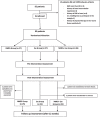A controlled randomized trial with a 12-week follow-up investigating the effects of medium-frequency neuromuscular electrical stimulation on pain, VMO thickness, and functionality in patients with knee osteoarthritis
- PMID: 38378564
- PMCID: PMC10877797
- DOI: 10.1186/s12891-024-07266-8
A controlled randomized trial with a 12-week follow-up investigating the effects of medium-frequency neuromuscular electrical stimulation on pain, VMO thickness, and functionality in patients with knee osteoarthritis
Abstract
Background: One of the major contributors to disability in Knee osteoarthritis (KOA) patients is weakness in the Quadriceps Femoris muscle. Neuromuscular electrical stimulation (NMES) has been used in rehabilitation for patients suffering from muscle weakness. Thus, the purpose of the study was to assess the effectiveness of NMES and exercise therapy, for improving pain, muscle weakness and function among patients with KOA.
Methods: A randomized controlled trial was conducted with 75 female patients diagnosed with KOA. Participants were divided into three intervention groups: NMES-only, exercise therapy (Exs) alone, and a combination of NMES and exercise (NMES + Exs). All patients underwent 12 supervised treatment sessions, three times a week. Outcome measures included pain intensity measured by visual analog scale (VAS), knee flexion range of motion (FROM), thigh muscle girth (TG), thickness of the Vastus Medialis Oblique (VMO), timed up and go test (TUG), six-minute walk test (6MWT), and WOMAC scores. Statistical analyses (ANOVA and Kruskal-Wallis) methods were done to compare the amounts at the baseline, immediately after treatment and after 12 weeks.
Results: The NMES group exhibited a significant reduction in pain at the 12-week follow-up compared to the other groups(p = 0.022). The NMES + Exs group showed better outcomes in terms of FROM, TG, and VMO thickness post-intervention (p < 0.0001, p < 0.004, p = 0.003, respectively) and at the 12-week follow-up (p < 0.0001, p < 0.0001, p < 0.0001, respectively). Additionally, NMES was superior in improving TUG and 6MWT post-intervention (p < 0.0001, p = 0.038, respectively) and during the follow-up assessments (p < 0.0001, p = 0.029, respectively). The NMES + Exs group achieved better WOMAC stiffness scores at both post-intervention and follow-up evaluations (p < 0.0001, p < 0.0001, respectively). Furthermore, at the 12-week follow-up, NMES + Exs group outperformed the others in WOMAC pain and function subscales (p = 0.003, p = 0.017, respectively), while the NMES group demonstrated better WOMAC total scores compared to the other groups (p = 0.007).
Conclusion: The combination of NMES and exercise seems to be an efficient approach for managing KOA, as it enhances knee flexion range and TG, increases VMO thickness, and improves WOMAC scores. On the other hand, NMES alone was found to be effective in improving the physical function of KOA patients.
Trial registration: IRCT20101228005486N7 (06-02-2020).
Keywords: Function; Interferential Current; Knee Osteoarthritis; NMES; Pain; Vastus medialis thickness.
© 2024. The Author(s).
Conflict of interest statement
The authors declare no competing interests.
Figures
References
-
- Vos T, Allen C, Arora M, Barber RM, Bhutta ZA, Brown A, et al. Global, regional, and national incidence, prevalence, and years lived with disability for 310 diseases and injuries, 1990–2015: a systematic analysis for the Global Burden of Disease Study 2015. Lancet. 2016;388(10053):1545–1602. doi: 10.1016/S0140-6736(16)31678-6. - DOI - PMC - PubMed
-
- Moezy A, Kavand S, Angoorani H, Nazari A, Masoudi S. A randomized controlled trial of two exercise protocols on pain, function, and vastus medialis thickness in women with knee osteoarthritis. J Pain Manage. 2021;14(2):133–144.
-
- Hafez AR, Alenazi AM, Kachanathu SJ, Alroumi A, Mohamed E. Knee osteoarthritis: a review of literature. Phys Med Rehabil Int. 2014;1(5):8.
Publication types
MeSH terms
LinkOut - more resources
Full Text Sources
Miscellaneous


